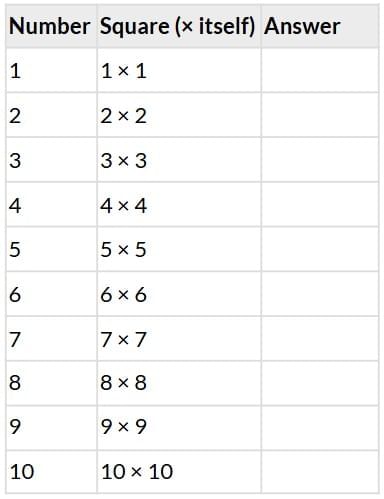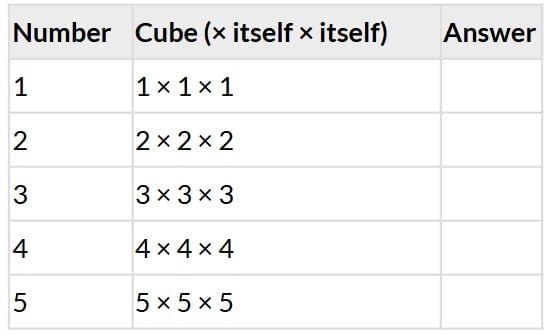Class 1 Exam > Class 1 Notes > Vedic Math for Junior Classes - English > Worksheet: Square and Cube Root
Worksheet: Square and Cube Root | Vedic Math for Junior Classes - English - Class 1 PDF Download
Section A: Understanding Square Numbers
A square number is the result of multiplying a number by itself.
Q: Complete the table below to find the squares of numbers from 1 to 10.
Section B: Find the Square Roots
Q: Write the square roots here:
- √64 = ______
- √100 = ______
- √49 = ______
- √36 = ______
- √25 = ______
Section C: Understanding Cube Numbers
A cube number is the result of multiplying a number by itself three times.
Q: Fill in the table below to find the cubes of numbers from 1 to 5.

Section D: Find the Cube Roots
Write the cube root of each number:
- ∛27 = ______
- ∛8 = ______
- ∛64 = ______
- ∛125 = ______
- ∛1 = ______
Section E: Vedic Math Trick – Squaring Numbers Ending in 5
Trick: To square a number ending in 5, multiply the first digit by the next digit and then write "25" at the end.
Example: 25 × 25 → 2 × 3 = 6 → Answer = 625
Now try:
15 × 15 = ___________
35 × 35 = ___________
45 × 45 = ___________
65 × 65 = ___________
Section F: Square Roots and Cube Roots (Finding the Number)
- What number times itself is 25? (Square root of 25)
- What number times itself 3 times is 8? (Cube root of 8)
- What number times itself is 64? (Square root of 64)
- What number times itself 3 times is 27? (Cube root of 27)
- You have 64 blocks in a cube shape. How many blocks on each side? (Cube root of 64)
For Solutions: Worksheet Solutions
The document Worksheet: Square and Cube Root | Vedic Math for Junior Classes - English - Class 1 is a part of the Class 1 Course Vedic Math for Junior Classes - English.
All you need of Class 1 at this link: Class 1
|
45 videos|23 docs|5 tests
|
FAQs on Worksheet: Square and Cube Root - Vedic Math for Junior Classes - English - Class 1
| 1. What is the difference between squaring a number and cubing a number? |  |
Ans.Squaring a number means multiplying the number by itself, which can be expressed as n² (n times n). For example, squaring 4 results in 4² = 16. Cubing a number involves multiplying the number by itself twice, represented as n³ (n times n times n). For instance, cubing 3 gives 3³ = 27.
| 2. How do you find the square root of a number? |  |
Ans.To find the square root of a number, you need to determine which number, when multiplied by itself, equals the original number. This is represented as √n. For example, the square root of 25 is 5, because 5 × 5 = 25. You can use methods such as prime factorization or estimation to find square roots.
| 3. What are some practical applications of square and cube roots in everyday life? |  |
Ans.Square and cube roots have various practical applications. For example, square roots are used in construction for calculating areas and in finance for determining standard deviations. Cube roots can be useful in volume calculations for three-dimensional objects, such as finding the side length of a cube when you know its volume.
| 4. How can you approximate the square root of a non-perfect square? |  |
Ans.Approximating the square root of a non-perfect square can be done using the method of averaging. For example, to approximate √20, find two perfect squares it lies between, such as 16 (4²) and 25 (5²). You can then average 4 and 5 to get an initial estimate of 4.5, and refine further by squaring 4.5 to check how close you are.
| 5. What is the significance of cube roots in mathematics and science? |  |
Ans.Cube roots are significant in mathematics and science because they help in understanding volumetric calculations and three-dimensional geometry. For example, when determining the side length of a cube from its volume, the cube root is used. Additionally, cube roots appear in various fields such as physics, engineering, and data analysis, where three-dimensional relationships are prevalent.
Related Searches
















